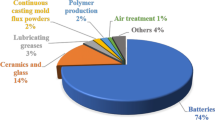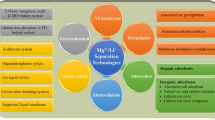Abstract
The ion exchange reduction of heavy metal ions from electrolytes has been studied by theoretical and experimental methods. It is established that high efficiency of the ion exchange is provided by metal ion diffusion through a thin subsurface layer of an ion exchanger with a thickness of \(\bar \delta = 1.6 \times 10^{ - 4} \) under conditions of the optimum solution flow velocity U 0, such that the time of ion penetration through the layer of water molecules adsorbed on the surface of pores in this layer is on the order of 10−2 s. In this case, the effective diffusion coefficient of metal ions in the subsurface layer is 4.5 × 10−7 m2/s, which is more than two orders of magnitude higher than the value in solution.
Similar content being viewed by others
References
V. G. Levich, Physicochemical Hydrodynamics (Fizmatgiz, Moscow, 1959; Prentice-Hall, Englewood Cliffs, 1962).
S. V. Plokhov and M. G. Mikhalenko, Izv. Vyssh. Uchebn. Zaved., Khim. Khim. Tekhnol. 45, 155 (2002).
S. V. Plokhov and N. A. Barinova, Ékol. Prom-st Ross., No. 9, 9 (2001).
L. D. Landau and E. M. Lifshitz, Course of Theoretical Physics, Vol. 1: Mechanics (Nauka, Moscow, 1982; Pergamon, New York, 1988).
N. E. Kochin, I. A. Kibel’, N. V. Roze, and J. R. M. Radok, Theoretical Hydromechanics (GITTL, Moscow, 1955; Interscience, New York, 1964), Vol. 2.
Yu. A. Kokotov and V. A. Pasechnik, Equilibrium and Kinetics of Ion Exchange (Khimiya, Leningrad, 1970) [in Russian].
GOST (State Standard) 22001-87: Reagents and High-Purity Substances. Method of Atomic-Absorption Spectroscopy. Determination of the Impurities of Chemical Elements (Standartizdat, Moscow, 1987).
Yu. Yu. Lur’e and A. I. Rybnikova, Chemical Analysis of Industrial Waste Waters (Khimiya, Moscow, 1974) [in Russian].
B. P. Nikol’skii, O. N. Grigorov, M. E. Pozin, B. A. Porai-Koshits, V. A. Rabinovich, F. Yu. Rachinskii, P. G. Romankov, and D. A. Fridrikhberg, Handbook of Chemistry (Khimiya, Moscow, 1964), Vol. 3 [in Russian].
V. Ya. Antonchenko, A. S. Davydov, and V. V. Il’in, Fundamentals of Physics of Water (Naukova Dumka, Kiev, 1991) [in Russian].
Author information
Authors and Affiliations
Additional information
__________
Translated from Pis’ma v Zhurnal Tekhnichesko\(\overset{\lower0.5em\hbox{$\smash{\scriptscriptstyle\smile}$}}{l}\) Fiziki, Vol. 31, No. 7, 2005, pp. 32–39.
Original Russian Text Copyright © 2005 by Trigub, Plokhov.
Rights and permissions
About this article
Cite this article
Trigub, V.I., Plokhov, S.V. Special features of heavy metal ion reduction from liquid electrolytes. Tech. Phys. Lett. 31, 284–287 (2005). https://doi.org/10.1134/1.1920372
Received:
Accepted:
Issue Date:
DOI: https://doi.org/10.1134/1.1920372




